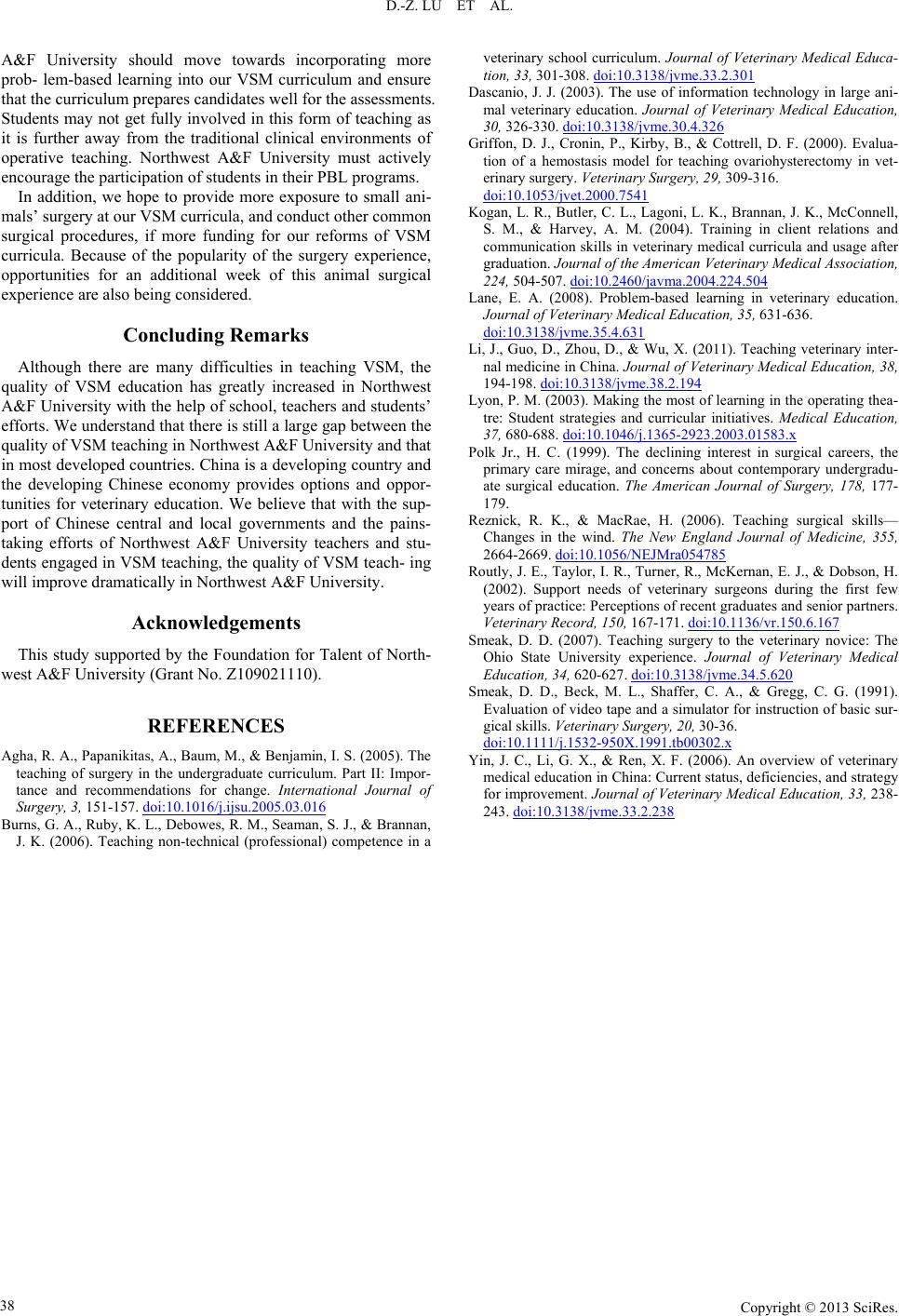
D.-Z. LU ET AL.
A&F University should move towards incorporating more
prob- lem-based learning into our VSM curriculum and ensure
that the curriculum prepares candidates well for the assessments.
Students may not get fully involved in this form of teaching as
it is further away from the traditional clinical environments of
operative teaching. Northwest A&F University must actively
encourage the participation of students in their PBL programs.
In addition, we hope to provide more exposure to small ani-
mals’ surgery at our VSM curricula, and conduct other common
surgical procedures, if more funding for our reforms of VSM
curricula. Because of the popularity of the surgery experience,
opportunities for an additional week of this animal surgical
experience are also being considered.
Concluding Remarks
Although there are many difficulties in teaching VSM, the
quality of VSM education has greatly increased in Northwest
A&F University with the help of school, teachers and students’
efforts. We understand that there is still a large gap between the
quality of VSM teaching in Northwest A&F University and that
in most developed countries. China is a developing country and
the developing Chinese economy provides options and oppor-
tunities for veterinary education. We believe that with the sup-
port of Chinese central and local governments and the pains-
taking efforts of Northwest A&F University teachers and stu-
dents engaged in VSM teaching, the quality of VSM teach- ing
will improve dramatically in Northwest A&F University.
Acknowledgements
This study supported by the Foundation for Talent of North-
west A&F University (Grant No. Z109021110).
REFERENCES
Agha, R. A., Papanikitas, A., Baum, M., & Benjamin, I. S. (2005). The
teaching of surgery in the undergraduate curriculum. Part II: Impor-
tance and recommendations for change. International Journal of
Surgery, 3, 151-157. doi:10.1016/j.ijsu.2005.03.016
Burns, G. A., Rub y, K. L., Debowes, R. M ., Seaman, S. J., & Br annan,
J. K. (2006). Teaching non-technical (professional) competence in a
veterinary school curriculum. Journal of Veterinary Medical Educa-
tion, 33, 301-308. doi:10.3138/jvme.33.2.301
Dascanio, J. J. (2003). The use of information technology in large ani-
mal veterinary education. Journal of Veterinary Medical Education,
30, 326-330. doi:10.3138/jvme.30.4.326
Griffon, D. J., Cronin, P., Kirby, B., & Cottrell, D. F. (2000). Evalua-
tion of a hemostasis model for teaching ovariohysterectomy in vet-
erinary surgery. Veterinary Surgery, 29, 309-316.
doi:10.1053/jvet.2000.7541
Kogan, L. R., Butler, C. L., Lagoni, L. K., Brannan, J. K., McConnell,
S. M., & Harvey, A. M. (2004). Training in client relations and
communication skills in veterinary medical curricula and usage after
graduation. Journal of the American Veterinary Medical Association,
224, 504-507. doi:10.2460/javma.2004.224.504
Lane, E. A. (2008). Problem-based learning in veterinary education.
Journal of Veterinary Medi c a l Education, 35, 631-636.
doi:10.3138/jvme.35.4.631
Li, J., Guo, D., Zhou, D., & Wu, X. (2011). Teaching veterinary inter-
nal medicine in China. Journal of Veterinary Medical Education, 38,
194-198. doi:10.3138/jvme.38.2.194
Lyon, P. M. (2003). Making the most of learning in the operating thea-
tre: Student strategies and curricular initiatives. Medical Education,
37, 680-688. doi:10.1046/j.1365-2923.2003.01583.x
Polk Jr., H. C. (1999). The declining interest in surgical careers, the
primary care mirage, and concerns about contemporary undergradu-
ate surgical education. The American Journal of Surgery, 178, 177-
179.
Reznick, R. K., & MacRae, H. (2006). Teaching surgical skills—
Changes in the wind. The New England Journal of Medicine, 355,
2664-2669. doi:10.1056/NEJMra054785
Routly, J. E., Taylor, I. R., Tu rner, R., McKernan, E. J., & Dobso n, H.
(2002). Support needs of veterinary surgeons during the first few
years of practice: Perceptions of recent graduates and senior partners.
Veterinary Record, 150, 167-171. doi:10.1136/vr.150.6.167
Smeak, D. D. (2007). Teaching surgery to the veterinary novice: The
Ohio State University experience. Journal of Veterinary Medical
Education, 34, 620- 627. doi:10.3138/jvme.34.5.620
Smeak, D. D., Beck, M. L., Shaffer, C. A., & Gregg, C. G. (1991).
Evaluation of video tape and a simulator for instruction o f basic sur-
gical skills. Veterinary Surgery, 20, 30- 36.
doi:10.1111/j.1532-950X.1991.tb00302.x
Yin, J. C., Li, G. X., & Ren, X. F. (2006). An overview of veterinary
medical education in China: Current status, deficiencies, and strategy
for improvement. Journal of Veterinary Medical Education, 33, 238-
243. doi:10.3138/jvme.33.2.238
Copyright © 2013 SciRes.
38